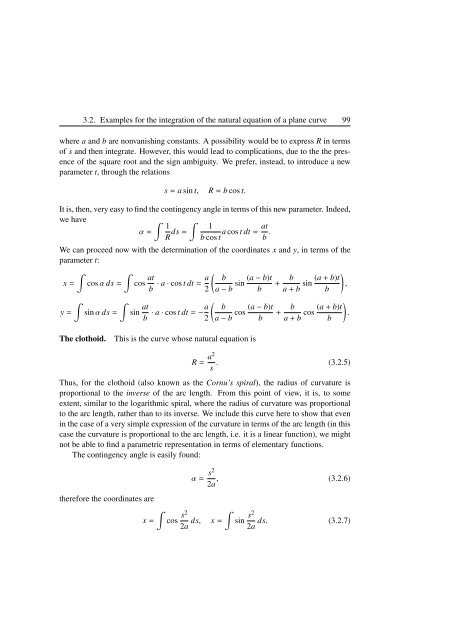Blaga P. Lectures on the differential geometry of - tiera.ru
Blaga P. Lectures on the differential geometry of - tiera.ru
Blaga P. Lectures on the differential geometry of - tiera.ru
Create successful ePaper yourself
Turn your PDF publications into a flip-book with our unique Google optimized e-Paper software.
3.2. Examples for <strong>the</strong> integrati<strong>on</strong> <strong>of</strong> <strong>the</strong> natural equati<strong>on</strong> <strong>of</strong> a plane curve 99<br />
where a and b are n<strong>on</strong>vanishing c<strong>on</strong>stants. A possibility would be to express R in terms<br />
<strong>of</strong> s and <strong>the</strong>n integrate. However, this would lead to complicati<strong>on</strong>s, due to <strong>the</strong> <strong>the</strong> presence<br />
<strong>of</strong> <strong>the</strong> square root and <strong>the</strong> sign ambiguity. We prefer, instead, to introduce a new<br />
parameter t, through <strong>the</strong> relati<strong>on</strong>s<br />
s = a sin t, R = b cos t.<br />
It is, <strong>the</strong>n, very easy to find <strong>the</strong> c<strong>on</strong>tingency angle in terms <strong>of</strong> this new parameter. Indeed,<br />
we have<br />
�<br />
α =<br />
�<br />
1<br />
ds =<br />
R<br />
1<br />
at<br />
a cos t dt =<br />
b cos t b .<br />
We can proceed now with <strong>the</strong> determinati<strong>on</strong> <strong>of</strong> <strong>the</strong> coordinates x and y, in terms <strong>of</strong> <strong>the</strong><br />
parameter t:<br />
�<br />
x =<br />
�<br />
cos α ds = cos at<br />
�<br />
a b (a − b)t<br />
· a · cos t dt = sin +<br />
b 2 a − b b<br />
b<br />
�<br />
(a + b)t<br />
sin ,<br />
a + b b<br />
�<br />
y =<br />
�<br />
sin α ds = sin at<br />
�<br />
b (a − b)t<br />
· a · cos t dt = −a cos +<br />
b 2 a − b b<br />
b<br />
�<br />
(a + b)t<br />
cos .<br />
a + b b<br />
The clothoid. This is <strong>the</strong> curve whose natural equati<strong>on</strong> is<br />
R = a2<br />
. (3.2.5)<br />
s<br />
Thus, for <strong>the</strong> clothoid (also known as <strong>the</strong> Cornu’s spiral), <strong>the</strong> radius <strong>of</strong> curvature is<br />
proporti<strong>on</strong>al to <strong>the</strong> inverse <strong>of</strong> <strong>the</strong> arc length. From this point <strong>of</strong> view, it is, to some<br />
extent, similar to <strong>the</strong> logarithmic spiral, where <strong>the</strong> radius <strong>of</strong> curvature was proporti<strong>on</strong>al<br />
to <strong>the</strong> arc length, ra<strong>the</strong>r than to its inverse. We include this curve here to show that even<br />
in <strong>the</strong> case <strong>of</strong> a very simple expressi<strong>on</strong> <strong>of</strong> <strong>the</strong> curvature in terms <strong>of</strong> <strong>the</strong> arc length (in this<br />
case <strong>the</strong> curvature is proporti<strong>on</strong>al to <strong>the</strong> arc length, i.e. it is a linear functi<strong>on</strong>), we might<br />
not be able to find a parametric representati<strong>on</strong> in terms <strong>of</strong> elementary functi<strong>on</strong>s.<br />
The c<strong>on</strong>tingency angle is easily found:<br />
<strong>the</strong>refore <strong>the</strong> coordinates are<br />
�<br />
x =<br />
α = s2<br />
, (3.2.6)<br />
2a<br />
cos s2<br />
�<br />
ds, x =<br />
2a<br />
sin s2<br />
ds. (3.2.7)<br />
2a












